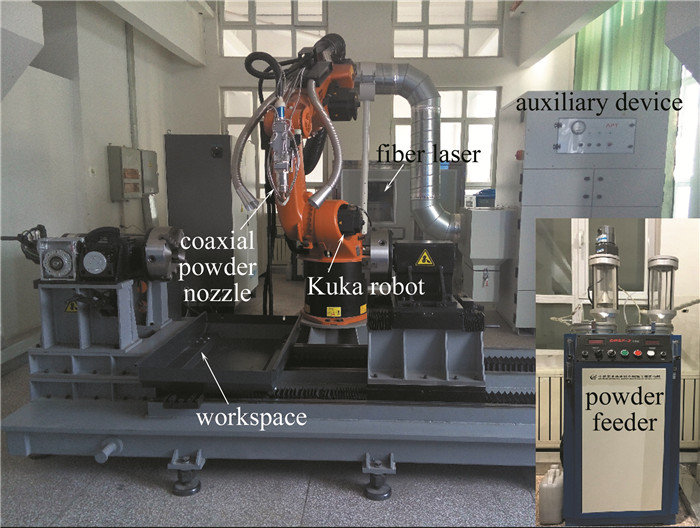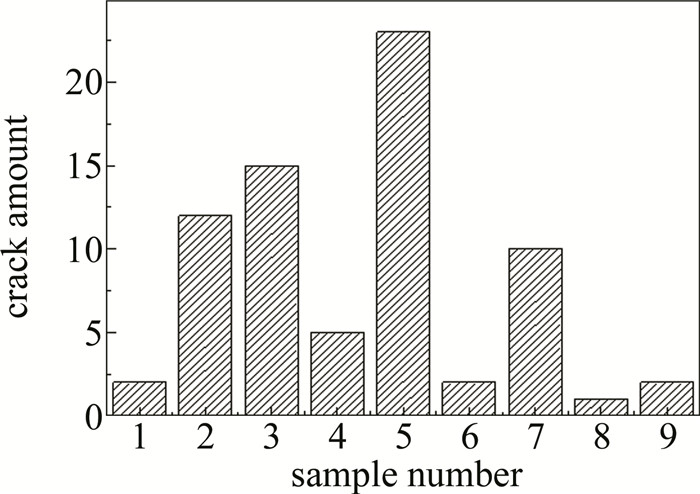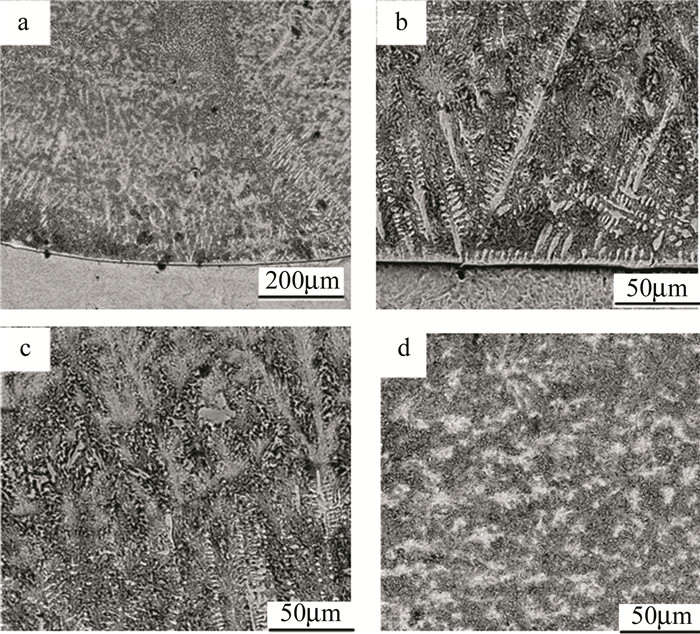Influence of laser cladding process parameters on crack and thickness of Ni60
-
摘要: 为了研究工艺参量对激光熔覆Ni60涂层裂纹及厚度影响,采用在45#钢基材表面熔覆Ni60合金粉末的正交试验方法,分析了影响裂纹产生的工艺参量的主次因素以及影响涂层厚度的主要因素,并对试验结果进行极差分析,获取了裂纹最少的最优工艺参量。结果表明,影响裂纹产生的主次因素为扫描速率>送粉速率>激光功率,裂纹最少的工艺参量为激光功率1400W,扫描速率4.0mm/s,送粉速率为1.0r/min,此时,在熔覆起始位置出现了一条短裂纹;对涂层厚度的影响程度主次因素为送粉速率>扫描速率>激光功率;经测量,熔覆层的硬度是基材的3.3倍,通过扫描电镜分析,涂层与基材形成良好的冶金结合,熔覆层晶粒组织均匀致密。该研究为Ni60合金粉末激光熔覆工程化应用提供了参考。Abstract: In order to study the influence of process parameters on crack and thickness of Ni60 laser cladding, the orthogonal experiment was designed by laser cladding Ni60 powder on the surface of 45# steel. The primary and secondary factors affecting the crack formation and coating thickness were analyzed, then, the range analysis method was carried out to obtain the optimal process parameters with the least cracks.The result showesthat the affecting order of crack is that scanning speed > powder feeding rate > laser power; and the process parameters with the least cracks areas follows: Laser power is 1400W, scanning speed is 4.0mm/s, powder feeding rate is 1.0r/min, and thereis only a short crack at the initial position of cladding by using the process parameter. The order of influence on coating thickness is as follows: powder feeding rate > scanning speed. Through microhardness test, the hardness of cladding layer is 3.3 times of that of substrate. Through scanning electron microscope analysis, the grain structure of cladding layer is uniform, and a good metallurgical combination with substrateis formed, which provided a reference for the engineering application of Ni60 alloy powder laser cladding.
-
Keywords:
- laser technique /
- process parameters /
- crack /
- thickness /
- microhardness
-
-
Table 1 Chemical composition of 45# steel(mass fraction)
C Si Mn Cr Ni Fe 0.004~0.005 0.002~ 0.004 0.005~0.008 ≤0.0025 ≤0.003 balance Table 2 Chemical composition of Ni60 powder(mass fraction)
C Si Fe B Cr Ni 0.005~0.011 0.035~ 0.055 < 0.05 0.03-0.045 0.15~0.2 balance Table 3 Factor and level table
level laser power/kW powder feeding rate/(r·min-1) scanning speed/(mm·s-1) A B C 1 1.0 0.8 4 2 1.2 1.0 6 3 1.4 1.2 8 Table 4 Analysis of cracks by orthogonal test
experimentalindex laser power/kW powder feeding rate/(r·min-1) scanning speed/(mm·s-1) A B C K1 9.7 5.7 1.7 K2 10 12 6.3 K3 4.3 6.3 16 extremum 5.7 6.3 14.3 optimal level group A3B2C1 Table 5 Analysis of coating thickness by orthogonal test
experimentalindex laser power/kW powder feeding rate/(r·min-1) scanning speed/(mm·s-1) A B C T1 0.465 0.31 0.525 T2 0.455 0.335 0.29 T3 0.36 0.635 0.465 -
[1] XU B Sh. Remanufacture engineering and its development in China[J]. China Surface Engineering, 2010, 23(2): 1-6(in Chinese).
[2] HAN Y Y, LU J J, LI J F, et al. Lathe spindle remanufacturing based on laser cladding technology[J]. China Surface Engineering, 2015, 28(6): 147-153(in Chinese). http://www.cnki.com.cn/Article/CJFDTotal-BMGC201506025.htm
[3] LU Y Zh, LEI W N, REN W B, et al. Matching and strengthening between Inconel718 cladding and K418 alloy blades by laser remanufacturing[J]. Laser Technology, 2020, 44(1): 54-60(in Chinese).
[4] GUO Sh R, SHANG H Ch, CUI L J, et al. Effects of laser cladding layers width on total indicated runout characteristics of steam turbine rotor surface[J]. Rare Metal Materials and Engineering, 2017, 46(3): 612-616. DOI: 10.1016/S1875-5372(17)30105-4
[5] GUO Sh R, YAO J H. Research on microstructure of laser cladding coatings on the surface of steam turbine rotor[J]. Laser & Infrared, 2016, 46(5): 532-536(in Chinese).
[6] CHEN L, GU Ch Zh, XIE P L. Numerical analysis of temperature field in laser cladding on tooth surface of helical gear shaft[J]. Chin-ese Journal of Lasers, 2011, 38(3): 0303006(in Chinese). DOI: 10.3788/CJL201138.0303006
[7] CUI L J, YU J H, GUO Sh R, et al. Laser cladding process and experimental study of pick based on Ni-based alloy[J]. Applied Laser, 2018, 38(5): 720-725(in Chinese).
[8] PENARANDA X, MORALEJO S, LAMIKIZ A, et al. An adaptive laser cladding methodology for blade tip repair[J]. International Journal of Advanced Manufacturing Technology, 2017, 92 (9/12): 4337-4343. http://www.onacademic.com/detail/journal_1000039910334410_6e8e.html
[9] CALLEJA A, TABERNERO I, EALO J A, et al. Feed rate calculation algorithm for the homogeneous material deposition of blisk blades by 5-axis laser cladding[J]. International Journal of Advanced Manufacturing Technology, 2014, 74 (9/12): 1219-1228. http://www.onacademic.com/detail/journal_1000036871379910_3cbb.html
[10] ZHAI J H, XU H Y, LIU Zh J, et al. Experimental study on laser cladding of Ni-based alloys on spheroidal graphite cast iron surface[J]. Laser & Optoelectronics Progress, 2017, 54 (10): 101412(in Chinese). http://www.researchgate.net/publication/320286288_Experimental_Study_on_Laser_Cladding_of_Ni-Based_Alloys_on_Spheroidal_Graphite_Cast_Iron_Surface
[11] ZHOU Sh F, ZENG X Y, HU Q W. Realization of laser cladding and crack-free ceramic-metal composite coatings[J]. Journal of Applied Optics, 2008, 29(1): 76-80(in Chinese). http://www.opticsjournal.net/Abstract.htm?aid=OJ080817000129HeKgNj
[12] ZHENG Ch Zh. Study on crack mechanism of laser cladding Ni based alloy[J]. China Metal Bulletin, 2018, 998(11): 83-84(in Chinese).
[13] CAO Y N, ZHANG Y M, JIE X H, et al. Study on control of crack in laser cladding Ni-based coating on steel[J]. Hot Working Technology, 2012, 41(18): 133-136(in Chinese).
[14] FU F X, CHANG G R, ZHAO X X, et al. Influence of laser spot diameter on cladding layer cracking[J]. Laser & Optoelectronics Progress, 2015, 52(3): 031401(in Chinese). http://www.opticsjournal.net/ViewObject.htm?oid=OJ150205000004iORnUq&otype=OJ
[15] LIU P L, SUN W L, WANG K D, et al. Effect of scanning speed on the properties of laser cladding nickel-based alloy coating[J]. Laser Technology, 2018, 42(6): 845-848(in Chinese).
[16] HAO Y B, WANG J, YANG P, et al. Microstructures and properties of tin-based babbitt metal prepared by laser cladding deposition[J]. Chinese Journal of Lasers, 2020, 47(8): 0802009(in Chin-ese). DOI: 10.3788/CJL202047.0802009
[17] ZHANG F Zh, SUN W L, WANG K D, et al. Optimization of laser cladding repair process parameters for thin-wall parts[J]. Surface Technology, 2019, 48(1): 168-174(in Chinese). DOI: 10.1007/s00170-020-05969-5
[18] LIU H F, TAN C K I, WEI Y F, et al. Laser-cladding and interface evolutions of Inconel625 alloy on low alloy steel substrate upon heat and chemical treatments[J]. Surface and Coatings Technology, 2020, 404 (12): 126607. http://www.sciencedirect.com/science/article/pii/S0257897220312779
[19] CHEN S, LI R, ZHENG Q, et al. Layered microstructure distribution and forming mechanism of laser-processed Ni-Fe-B-Si-Nb-C amorphous composite coatings[J]. Materials Transactions, 2016, 57(10): 1807-1810. DOI: 10.2320/matertrans.M2016189
[20] WANG Zh Y, LIN J, LEI Y P, et al. Microstructure and properties of Stellite6 coating prepared by laser cladding[J]. Laser & Infrared, 2020, 50(10): 1172-1177(in Chinese). http://www.sciencedirect.com/science/article/pii/S1003632620652736




 下载:
下载:






